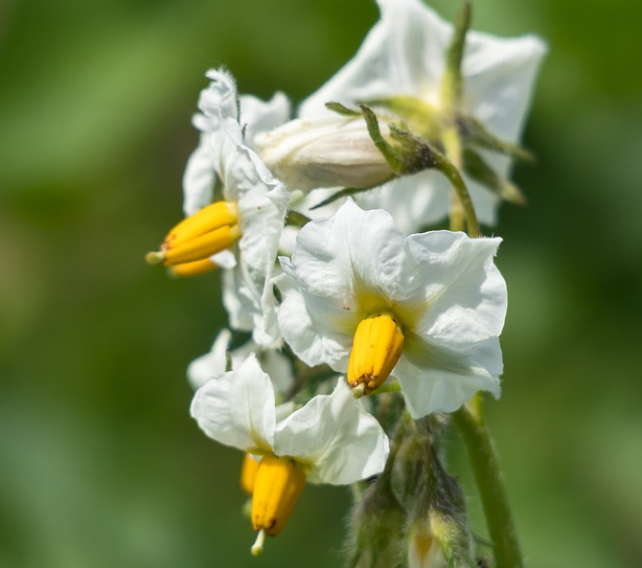Growing Potatoes in your Backyard Garden
Calling all potato-lovers! If you’ve ever thought about growing potatoes at home, you’ll be pleased to find they’re quite easy to grow.
Potatoes are one of the most bountiful vegetables you can grow- 1 pound of seed potatoes has the potential to grow 10 lbs of potatoes for harvest. So if you love potatoes and plan to try your hand at them this year, here’s what you need to get started.
Which Potatoes should I grow?
There are many different and delicious varieties of potatoes out there. The Co-Op carries several different cultivars of potatoes. See this table for more information about our potatoes this year. Remember,
Name | Appearance | Season | Days to Maturity | Qualities |
Dark Red Norland | Early | 90-100 | Red and early, Good boiled or in potato salad. | |
Yukon Gold | Early | 80-95 | Yellow, thin skinned, good for mashed potatoes. | |
Red Pontiac | Late | 70-120 | Deep eyes, white waxy flesh. Good for chips and fries. | |
Superior | Early | 85-90 | White, waxy flesh, good for potato chips and fries. | |
Keuka Gold | Mid | 90-100 | Yellow and hardy, good for roasting or mashing. | |
Eva | Early -Mid | 65-80 | Hardy white potato, good for mashing or roasting. | |
Goldrush Russet | Mid | 90-100 | Good for storage and roasting or baking. |
How do Potatoes Grow?
Growing potatoes from potato starts is simple. Cut larger potatoes into chunks at least an inch and a half wide, making sure each chunk has at least one eye on it. This is where the plant will sprout from, so it is a necessary step.
It’s important to note that supermarket potatoes typically don’t grow very well if you try to start them in this manner. Most have been treated to not sprout or have other pesticides on them, so stick to growing seed potatoes from a reputable seller.
Once you’ve prepared your potato pieces, lay them out flat on a tray to dry out a little and the flesh has formed a dry skin. Once they’re reached this stage, they are ready to be planted in the ground or in a container.
Potatoes are not particularly demanding plants to grow. They can be planted as soon as the ground is warm enough to be worked. They grow best in sunny spots with ample space around each plant, so make sure you plant them with at least a foot of space between each plant. Start with 4-6 inches of good, well-draining soil or compost. Bury the potato pieces in the soil cut side down, making sure they’re fully covered. Potatoes like sandy, loamy soil on the acidic side. Keep the soil moist but not swamped with water otherwise the potatoes will rot.
What do I need to grow Potatoes?
You’ll need a bright, sunny spot, lots of good-quality soil and water, a spade, and if you like, some slow-release organic fertilizer. If you’re growing them in a container, pick one at least the size of a five-gallon bucket or larger. Make sure the container is opaque and won’t let any sunlight reach through to the potatoes.
Once you see green shoots poking up out of the ground, pile more dirt on top of them. This is the pattern you’ll continue throughout the potatoes’ growing season. This process is called “hilling”. By covering the stem of the growing shoots, it encourages growth of the potato tubers.
If growing in a container, make sure that you have the appropriate sized container for all that dirt you’ll be adding. Adding a layer of mulch to your potato hill can help protect them from overheating. You start out with very little, but by the time you’re ready to harvest from your potato plant you will have a real hill.
When Can I Harvest?
Potato plants are lovely, leafy, and will eventually flower. Once they’ve flowered, you can harvest the potatoes. Early season potatoes are the first to mature and can typically be harvested in early summer. You’ll see the most mature “new” potatoes poking up out of the ground. Those are the ones you want to pick. The youngest, least-ripe potatoes will be deepest in the soil and may be uncovered when you harvest the ones on top. You can cover those back up with dirt and harvest them later.
Storage potatoes can be harvested once the plant’s been done flowering for a couple of weeks to ensure the growth cycle is complete. These potatoes keep the longest if stored properly through the fall. To cure potatoes for storage, lay them unwashed in a cool and dark place for one to two weeks. Throw away any mushy ones. You can then wash off any dirt, dry them, and store them together in bags to enjoy long past summer.
